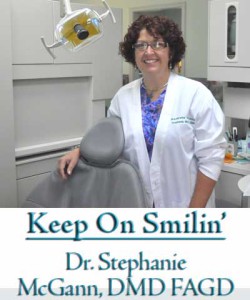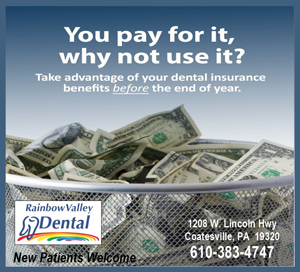Channel 6 ‘consumer’ report may be encouraging patients, dentists to break the law
By Dr. Stephanie McGann, DMD FAGD, Columnist, The Times
 This week while walking by the television in my reception room, I was stopped by a consumer piece on Channel 6 (WPVI) Action News “What’s the Deal?” The segment, by reporter Nydia Han was about finding the best quality dentists with the best prices. The piece was based on the latest issue of Delaware Valley Consumer Checkbook. To be fair until now I had never heard of the Consumer Checkbook. I did some reading and what I found was very concerning.
This week while walking by the television in my reception room, I was stopped by a consumer piece on Channel 6 (WPVI) Action News “What’s the Deal?” The segment, by reporter Nydia Han was about finding the best quality dentists with the best prices. The piece was based on the latest issue of Delaware Valley Consumer Checkbook. To be fair until now I had never heard of the Consumer Checkbook. I did some reading and what I found was very concerning.
What worries me is the premise of this story. Fees from one practice to another were compared by a secret shopper. This secret shopper stated that fees for a filling on a molar ranged from $90.00 – $412.00 what it doesn’t say is what was actually compared. A small filling using mercury containing amalgam (one surface) may very well be around $90 on some discount plans. A very large four surface filling in modern composite may have a fee of approaching $412 in some offices.
There more than 12 CDT codes for “molar fillings.” This lack of detail is akin to calling up a restaurant and asking for the price for dinner without choosing a meal. Then calling another restaurant and asking to compare costs. Sounds silly, but that is really what is being reported here. The article listed a score based on these shopper fees as well as a patient satisfaction survey.
Now for the article buster: most dental practice management companies advise office staffs to avoid quoting fees over the phone. Each fee is tied to a CPT procedure code and pre-set by insurance contracts. Quoting the right fee (right code) without seeing the patient is nearly impossible.
Another part of the piece suggested that if two dentists had two different treatment plans one must be wrong. That premise is flawed, if not down right deceptive.
Not all dentists’ treatment plans in the same way. This report assumes that if one dentist wanted to restore six teeth and another only four something was wrong. Some practitioners are more aggressive and prefer to treat a tooth before it hurts to avoid more costly services (like root canals) later. Other dentists take a more wait and see approach. There a many opinions on treating cracked teeth or when a tooth needs a crown. There is no right or wrong. Much like two chefs won’t prepare the same meal exactly the same way, dentistry is as much art as it is medicine.
Ask any dental student – they can show a case to one instructor and get one opinion, while a second instructor may have another treatment option and a third instructor may still have another take on the case. None are wrong, yet the path to get from one point to another may vary.
Second opinions are always a great idea if you have concerns about your recommended treatment. Copies of your x-rays and treatment plan will help the consulting dentist give you a comparison. Many insurance carriers do not cover the extra exam that is necessary for a second opinion. Be prepared to pay out of pocket for that service.
Ms. Han on Channel 6 was adamant about negotiating your fees with your dentist. Be very careful about this. If you have insurance and are in-network with your provider there is a contracted previously set fee with your company. The negotiation has already been done and under most circumstances the contract precludes any further discounting of fees. Don’t ask your dentist to waive the co-pay; waiving a co-pay is insurance fraud. Both the dentist and patient can be subject to prosecution.
If you are out of network and are looking to save money on dentistry, review your policy and see if a network option is available. The legal statute is clear; charging cash patients less than patients covered by insurance is fraud. While saving money and having clear understanding of fees is ideal, attempting to negotiate a better deal can be placing doctor and patient in legal jeopardy.
As dentists we understand that many patients have financial constraints. There are numerous options and ways to provide great dental care at affordable fees. Patients without insurance should compare costs and treatment options. Most importantly, never skip the preventive visits. The best way to save money is to stay current with regular exams and hygiene visits. The old adage, “a stitch in time saves nine”, is words of wisdom for dental consumers.
There are a wide range of types of dental practices, much like restaurants. You can get a cheeseburger at a fast food joint for a lot less than a cheeseburger at a local steak house. Both are cheeseburgers, both will satisfy a hungry person. However, to compare the two is ridiculous.
Dentistry is much the same, there is the range of very exclusive private practices that don’t even take insurance, to high-volume clinics that provide care at the lowest possible costs. Most dental practices are somewhere in the middle. Choose a dentist you are comfortable with, ask questions and choose the dental treatment that is right for you.
While the information provided in the Consumer Checkbook gives prospective patients a way to score dentists, based on how well their patients like them and price comparison, this alone is no substitute for finding a provider that listens to your needs, evaluates you carefully and pays attention to details.
I have to ask – Are we going to start shopping fees for our next cardiac procedure? Should brain surgeons need Groupon?
Dr. Stephanie McGann, who has more than two decades of dental practice experience, is a resident of the Unionville area and along with her partner, Dr. Marie Scott, operates The Brandywine Smile Center, a family-friendly dental practice in Concordville. Dr. McGann has opened a new practice in Valley Township, Rainbow Valley Dental. She is a Fellow of the Academy of General Dentistry.






